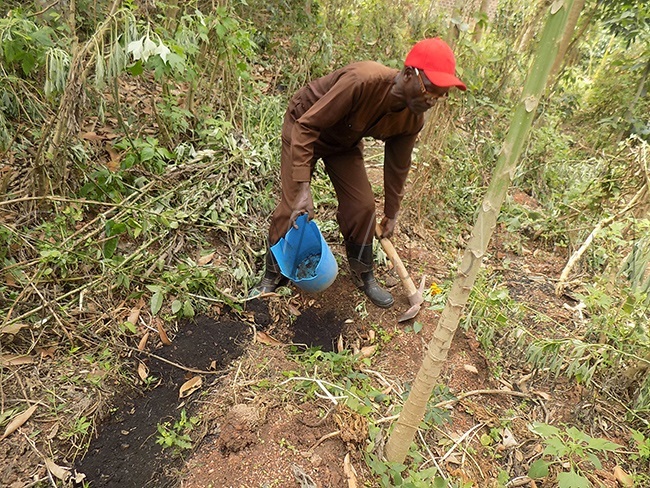The hidden treasure in charcoal dust as a fertilizer
HARVEST MONEY | FARMING |
Peter Byaruhanga is an interesting agriculturist! Around his home in Bukalasa, near Bukalasa agriculture training college is all kinds of plants under research and innovations. However, the most interesting innovation is the use of charcoal dust as a fertilizer or farm soil additive.
"This is one resource that many Ugandan farmers do not know about," he says as he digs around the base of a coffee tree. As he digs, the soils look quite black, irrespective of the dry season that was still ravaging through the area.
"You see, these trees are just one year old," he says. The trees look good. The stems look strong. The branches are long, hence a promise of good production. He then points at one of the avocado trees in his garden. The trees had lots of fruits and were largely green irrespective of the dry spell in early February. "It produces all year round because I used charcoal dust to cushion moisture around it," he says.
Byaruhanga qualified from Makerere University, as an agriculturist with a Bachelor's degree in Agriculture, majoring in extension services in 1977.
He worked as an extension worker in Luwero, before he was elevated to the District Agriculture Officer (DAO) position in Luwero district.
He worked up to 1998 when he retired into private agriculture research.
"While I worked here, I bought myself this land, where I have continued to carry out my agriculture research even in retirement," he says.
His land is covered by all kinds of crops, including coffee, bananas, jackfruit, mangoes, avocado, oranges, etc.

Need for fertilizers
According to researchers, deterioration and chemical degradation of soils are severe, at the moment, not only in Uganda but across the world. It is expressed as soil compaction, poor tubes, surface crafting (ph), slow water seepage, low water draining, low nutrients, and low nutrient retaining, and also decreasing crop productivity.
"We have been using the soils repeatedly for so many years and now they are obviously exhausted," observes Prof. Kitungulu Zaake, a soil scientist from Makerere University. Kitungulu facilitated the training on soil management at the Harvest Money expo.
Kitungulu explained that after a year, farmland soils become low in organic matter and the quality turns poor. So currently, most farmland soils have organic matter content lower than three percent.
This is why increased use of organic soil fortifiers, like charcoal as a supplement to organic fertilizers may provide positive results. "There is no way we can continue farming without using fertilizers or soil fertility enhancers of any kind," Kitungulu advises.
Unfortunately, in Uganda, the majority of farmers are yet to adapt to the use of fertilizers on the farm. "Fertilizers are expensive, we cannot afford them," says Patrick Kitaka, a farmer from Bamunanika, Luwero. But with easily accessed soil fertility fortifiers like charcoal dust, Kitaka should not be so worried.
How it works
Byaruhanga says that charcoal is a fine-grained, porous black carbon, and it is generated from plant materials. And it is non-toxic to plants. There are many tiny pores in charcoal so, once applied to the soil, the pores will allow air to diffuse into the soil.
Meanwhile, the tiny pores will hold water and nutrients and later supply it to plants.
More important, unlike other organic fertilizers, charcoal is very stable and it will not decompose to carbon dioxide. So, once applied, it will stay in the soil for hundreds to thousands of years.
"Therefore, to summarize, the high stability and porosity make charcoal a better fertilizer than other organic materials," Byaruhanga explained. Because it survives in the soils for many years, there is no need for re-application throughout the plant cycle.
"There are plants like coffee, oranges, tea, cocoa, and others that remain on the farm for many years. You will not need to re-apply the dust on the crops," he says.
Plenty of charcoal dust
A walk around most urban areas shows a lot of ‘wasted' charcoal dust among charcoal dealers. "I sell a 100kg sack of charcoal dust at sh3,000," says Moses Mugabo, a charcoal dealer in Kisaasi.
Mugabo says sometimes, he does not even have use for the charcoal dust. "I even give it away," he says.
However, none of the buyers of this dust are farmers. "I sell it to electricians who are fixing electricity metre boxes on houses. Apparently, they use charcoal dust as the main base during the electricity ‘earthing' process.
There are many charcoal dealers across all major towns in the country, who have got nothing to do with the heaps of charcoal dust that they collect every year. "I encourage farmers to go for this unused natural resource," Byaruhanga says.
Application on the farm
Charcoal dust is good for long-staying crops like coffee, bananas, cocoa, oranges, mangoes, etc.
According to Byaruhanga, for each pit of 2feet deep by 2 feet wide, you need at least five kilograms of charcoal dust. "You apply it at least two weeks before planting," he says.
He explains that after digging the pit, you apply the dust and then cover it up with topsoil.
This means that if an acre has 450 pits for planting in crops, you need at least four to five 100kg sacks to cover it up. "At the current cost, that is just sh12,000 to sh13,000," Byaruhanga says.
After applying the charcoal dust, a farmer can then apply 5kgs of organic fertilizer on the same crop. "With this combination, the soil may take several years without showing any need for fertilizers," he says.